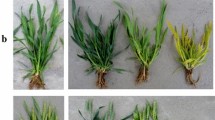Summary
Investigation of a variegated condition in the soybean variety Lincoln indicates instability at the Y locus. Leaf sectors of chlorophyll-less yellow tissue occur in distinct heritable patterns; some leaves have small flecks of yellow tissue (late occurring mutations) and others possess large areas or whole leaflets (early occurring mutations).
There is evidence that this allele, Y m18 , mutates to the wild type, Y, which is green and stable and to the recessive, y, which is yellow and lethal in the seedling condition. (With an increase in the amount of yellow tissue there is an increase in the frequency of lethals.) However, changes from one type to the other are observed, and patterns of variegation representing different states of the instability are described. These depend upon the time and frequency of mutation events.
Evidence is presented to support the hypothesis that this instability is controlled by a factor that resides at the locus. Such a factor governs the timing of the mutation events and is related to similar elements in maize, which are part of specific mutable systems. Control of variegation of the Y m18 locus is compared with the models proposed for the cases of instability in maize.
Zusammenfassung
Die Untersuchung eines variegaten Zustandes bei der Sojabohnensorte ‘Lincoln’ führte zum Nachweis einer Instabilität des Y-Locus. Blattsektoren mit chlorophyllfreiem gelbem Gewebe traten in bestimmten erblichen Mustern auf. Einige Blätter wiesen kleine Flecken gelben Gewebes auf (spät eingetretene Mutationen), während andere große Flächen oder vollständig gelbe Blättchen besaßen (früh eingetretene Mutationen).
Es gibt Beweise dafür, daß das entsprechende Allel Y m18 sowohl zum stabilen Wildtypallel Y, mit grünem Phänotyp, als auch zum rezessiv gelben y, das im Sämlingsstadium letal wirkt, mutiert. (Eine Zunahme der Menge gelben Gewebes ist mit einer Zunahme der Letalfrequenz verbunden.) Umwandlungen eines Typs zu einem anderen werden beobachtet und Variegationsmuster beschrieben, die unterschiedliche Stadien der Instabilität verkörpern. Diese hängen von dem Zeitpunkt und der Frequenz der Mutationsereignisse ab.
Es werden Beweise vorgelegt, die die Hypothese stützen, daß diese Instabilität durch einen Faktor kontrolliert wird, der sich am Locus befindet. Ein Faktor dieser Art kontrolliert das zeitliche Auftreten der Mutationsereignisse. Er ist mit ähnlichen Elementen des Maises verwandt, die Teile eines spezifisch mutablen Systems sind. Die Kontrolle der Variegation durch den Y m18 -Locus wird mit den Modellen verglichen, die für die Fälle der Instabilität beim Mais vorgeschlagen wurden.
Similar content being viewed by others
References
Brink, R.A., and R.A. Nilan: The relation between light variegated and medium variegated pericarp in maize. Genetics 37, 519–544 (1952).
Demerec, M.: Unstable genes. The Botanical Review 1, 233–248 (1935).
Harrison, B.J., and J.R.S. Fincham: Instability at the Pal locus in Antirrhinum majus. Heredity 19, 237–258 (1964).
Hondelmann, Walter: Untersuchungen an einem mutablen Blütenfarbgen von Callistephus chinensis Nees. Z. Vererbungslehre 90, 159–181 (1958).
Imai, Yoshi Taka, and Kiyoo Tabuchi: Recurrent mutation in the flaked alleles of Pharbitis purpurea. Jour. of Genetics 35, 433–446 (1938).
McClintock, Barbara: Chromosome organization and genic expression. Cold Spring Harbor Symposia Quant. Biol. 16, 13–47 (1951).
McClintock, B.: Induction of instability at selected loci in maize. Genetics 38, 579–599 (1953).
McClintock, B.: Controlling elements and the gene. Cold Spring Harbor Symposia Quant. Biol. 21, 197–216 (1956a).
McClintock, B.: Intranuclear systems controlling gene action and mutation. Brookhaven Symposia in Biology 8, 58–74 (1956b).
Peterson, Peter A.: The pale green mutable system in maize. Genetics 45, 115–133 (1960).
Peterson, Peter A.: Mutable a 1 of the En system in maize. Genetics 46, 759–771 (1961).
Peterson, Peter A.: Influence of mutable genes on induction of instability in maize. Proc. Iowa Acad. Science 70, 129–134 (1963).
Peterson, Peter A.: Novel variation resulting from the effect of a regulatory-controller system on a locus in maize. Genetics 54, 354 (1966a).
Peterson, Peter A.: Phase variation of regulatory elements in maize. Genetics 54, 249–266 (1966b).
Peterson, Peter A.: The origin of an unstable locus in maize. Genetics 59, 391–398 (1968a).
Peterson, Peter A.: Mutations coincident with transposition of elements in maize. Proc. XII. International Congress of Genetics, Tokyo 1, 253 (1968b).
Peterson, Peter A., and C.R. Weber: Control of variegation of the Y m allele in soybeans. Agron. Abstract page 76 (1964).
Author information
Authors and Affiliations
Additional information
Communicated by W. Seyffert
Joint contribution from the Iowa Agricultural and Home Economics Experiment Station, Ames, Iowa (Projects 1335 und 1179) as Journal Paper No. 5635.
Former Agronomist, Crops Research Division, ARS, USDA, and Professor Iowa State University; now Research Director, Peterson Seed Company.
Rights and permissions
About this article
Cite this article
Peterson, P.A., Weber, C.R. An unstable locus in soybeans. Theoret. Appl. Genetics 39, 156–162 (1969). https://doi.org/10.1007/BF00272524
Received:
Issue Date:
DOI: https://doi.org/10.1007/BF00272524




